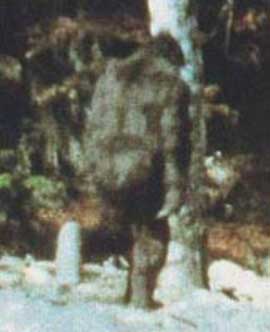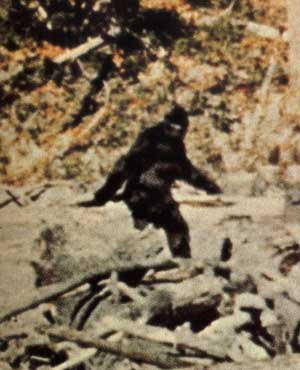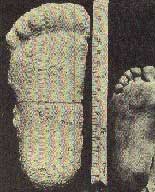 |
|
The famous Bigfoot footage filmed in 1967 by Roger Patterson at Bluff Creek, Northern California (Photo: compuserve) |
An image, a piece of evidence, or a footprint cannot become definitive factors. Concrete evidence is always needed: a skeleton or a skull, which have yet to be discovered. One day we may confirm the existence of the “man-ape”, but for now, the creature known as Bigfoot remains a significant mystery.
Described as a bipedal omnivore, Bigfoot is said to be nocturnal, residing in mountainous forests or near water sources. It stands approximately 7 to 12 feet tall and weighs between 550 to 1,000 pounds. Its health, hearing, sight, and sense of smell surpass those of humans. However, it is characterized as harmless and non-aggressive. It is called Bigfoot due to its large footprints left on the ground (up to 18 inches long).
One of the most perplexing pieces of evidence is a film showing a creature of this kind wandering through a forest. This footage was captured in 1967 by Roger Patterson at Bluff Creek, Northern California. Many scientists have carefully analyzed the film and concluded that no special effects were used in its creation. The existence of Bigfoot is only evidenced by the footprints it leaves behind, which have been studied by experts, particularly anthropologist Grove S. Krantz, who conducted anatomical and biomechanical research.
The Return of Bigfoot?
 |
|
An image of Bigfoot (Photo: geocities) |
After a period of quiet, the topic of Bigfoot has resurfaced recently, particularly in Canada. In April 2005, a ferry operator on the Manitoba River filmed a large, dark, indistinct creature moving along the riverbank. It remains unclear what it was – either Bigfoot or a bear… – but it became a hot topic of discussion.
Three months later, near Yukon, a Teslin resident named Trent Smarch discovered a tuft of large black hair in a forest where he and locals had heard rumors of a mysterious, large creature. They believed it to be Sasquatch, a human-like version of Bigfoot, known for its thick fur and large stature in Canada. This discovery quickly gained widespread attention across North America and around the world, leading many to wonder if this tuft of hair might finally prove the existence of Bigfoot, a creature that has long been a subject of heated debate. The hair sample was sent to the University of Alberta for wildlife geneticist David Coltman to analyze the DNA and compare it with databases of local animals. It wasn’t until July 28, a week after testing, that results were announced, providing initial insights into the study of Bigfoot evidence.
Bigfoot began to form in our minds
|
|
|
Comparison of Bigfoot’s foot with a normal human foot (Photo: tqnyc) |
in 1959, following a report on the discovery of large footprints in Bluff Creek, California. Nearly half a century later, the discussion of Bigfoot’s existence was reignited through newly found footprints and published photographs. However, after five years of research, the truth revealed itself in a rather amusing way: “Bigfoot hair” turned out to be hair from a bison, bear, or moose, and “Bigfoot blood” was simply a type of transfusion fluid!
At a press conference, Coltman revealed the results of the DNA analysis on the hair sample believed to belong to Bigfoot: it matched entirely with bison hair! This bison species is quite common in the area, suggesting that the expectations and perceptions of the public were influenced by the events that occurred three months earlier in Manitoba. Nonetheless, this result did not discourage witnesses or believers in the existence of Bigfoot.
Currently, all that is considered evidence of Bigfoot has been debunked, remains unidentified, or originates from well-known animals. The mystery of Bigfoot persists, and the search continues.
Tran Thanh Phong


















































